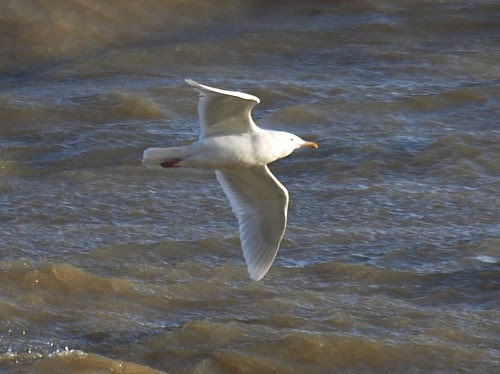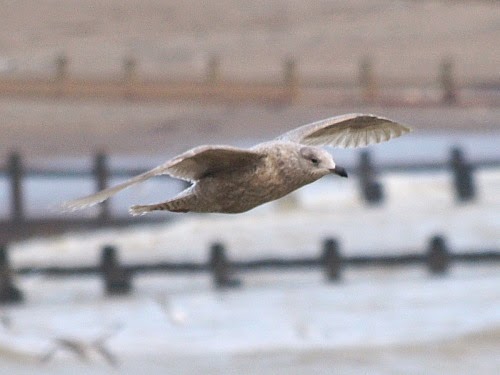Little Gull 2 (1 first-winter)
Glaucous Gull 1 adult
Kumlien's Gull 1 juvenile/first-winter dark individual
Adult Glaucous Gull at Littlehampton
First-winter Little Gull at Littlehampton
First-winter Black-headed & Little Gull at Littlehampton
Adult winter Mediterranean Gull at Littlehampton
Juvenile/First-winter Kumlien's Gull at Littlehampton
When seen at distance and in strong sunlight as it fed amongst a flock of Black-headed Gulls its overall colouration was very creamy so reminiscent of a juvenile glaucoides
It often foot-paddled dropping its pink legs
It appeared of quite delicate proportions whilst flying amongst the Black-headed Gulls again reminiscent of glaucoides
Its darker outer webs to the upper sides of its outer five primaries were readily apparent as the bird approached us
Its head, neck, beast and belly appeared considerably coarser marked darker greyish than we associate with glaucoides
Appearing full-bodied and not so sleek as glaucoides
Bill appearing black and slender nicely set-off by its narrow white nose-band
On the water it showed superb complete dark grey-brown centres to its primaries with contrasting narrow pale fringes around the entire tips so a close match to the pattern described for a dark individual
In more overcast conditions it definitely took on an overall more colder brown-grey appearance than glaucoides as described by Van Duivendijk
As described in Van Duivendijk and Olsen its primary projection didn't strike us as long as in glaucoides.
Its tertials appeared grey-brown centred with some pale notching along their fringes with broad whitish tips. A near-identical tertial pattern is shared with an overall very similar dark individual photographed in Ireland here: http://www.theinkednaturalist.co.uk/2012-what-a-year/
As described in Van Duivendijk its bill appeared slightly heavier than glaucoides. At ant range it appeared all dark but close views showed it mirroring glaucoides in having a very slightly paler grey basal two-thirds
In more deliberate flight it then appeared far more stout, hefty, powerful and broad-winged than our impressions of glaucoides. Whilst overall darker too it only shows the merest hint of a diffuse dark trailing edge to its outer primaries and therefore much weaker than that of a Thayer's Gull. Furthermore there is only a vague impression of a very slightly darker secondary bar.
Juvenile/First-winter Kumlien's Gull at Littlehampton
The pattern of its outer wing with its pale inner primaries and darker outer primaries are portrayed being the reverse of glaucoides. Also its dark primary coverts are shown to good effect. In many ways its 'least pleasing' attribute was its tail pattern. Whilst basally often appearing quite dark the broad pale tips to its tail feathers created a broad pale terminal band captured much better by JFC here:
Juvenile/First-winter Kumlien's Gull at Littlehampton (JFC)









































